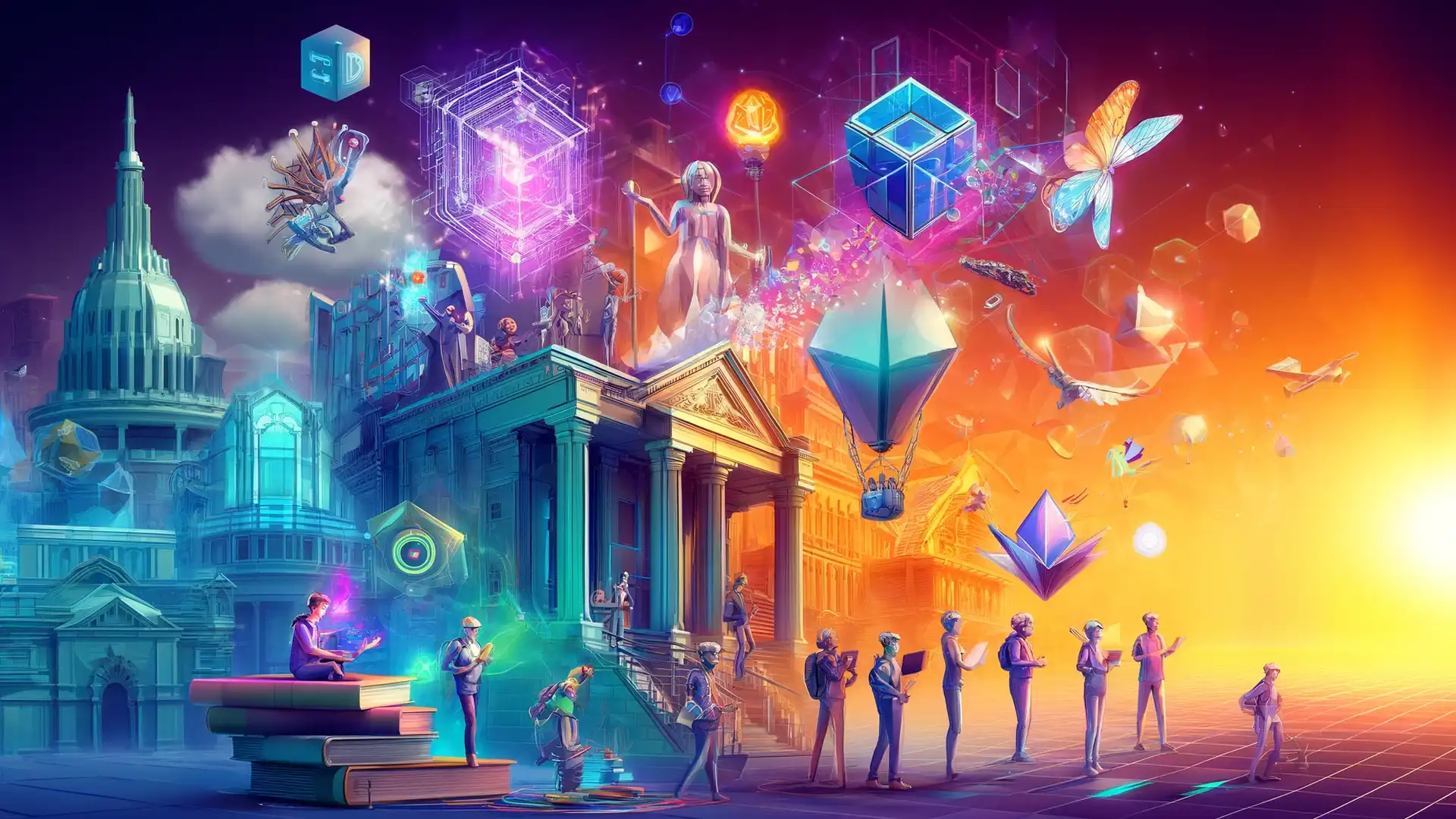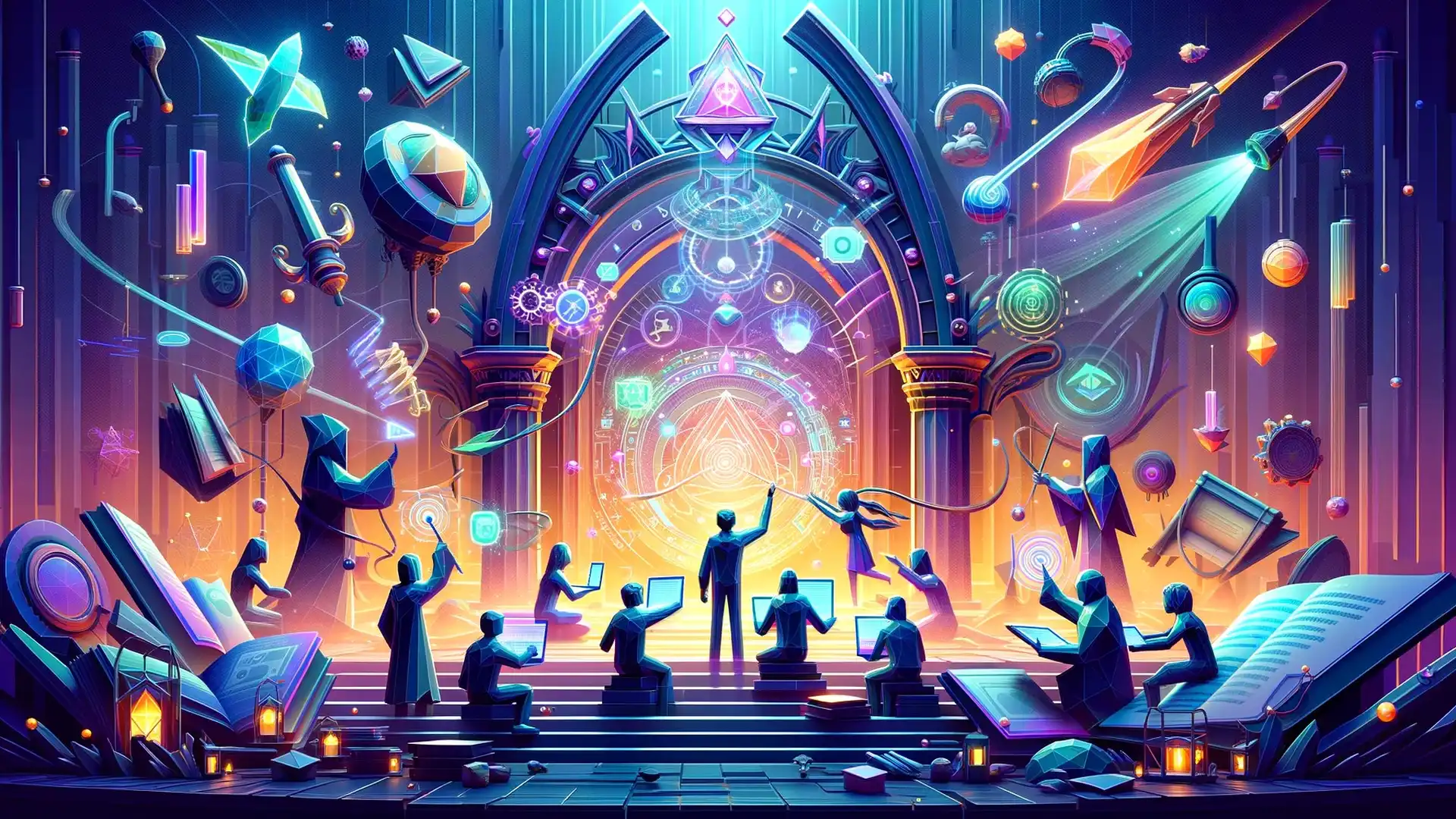Practical Applications of NFT and Blockchain in Education and Beyond

 Author:
Artem Grigoriev
Author:
Artem Grigoriev
Revolutionizing Education: NFTs and Blockchain's Transformative Potential
Step into a world where education transcends traditional boundaries. It is enhanced by the cutting-edge application of Non-Fungible Tokens (NFTs) and blockchain technology . These digital innovations are redefining our understanding of academic achievements and credentials. They augment student interaction with learning materials and revolutionize how schools manage administrative tasks . NFTs, unique digital items akin to one-of-a-kind collectibles, and blockchain, a robust technology that records data making it nearly impossible to alter, hack, or cheat, are at the forefront of this change.
📘 This article complements: "The Complete Guide to NFT Credentials". Explore it to find answers to all your questions;)
Educational technology experts are confident that these technologies could significantly enhance educational equality and access . This is especially true in regions where conventional resources are sparse. With NFTs and blockchain, educational systems can evolve to be more inclusive. They offer equal opportunities for learners from diverse backgrounds.
At the heart of this transformative wave is blockchain's ability to provide immutable (unchangeable) and transparent (visible and understandable to everyone) records of student achievements. This reliable digital ledger system ensures that academic records are authentic and permanent. It drastically reduces the risks of credential forgery and fraud. Imagine a world where your educational achievements are securely recorded. They are perpetually accessible and widely recognized, eliminating the reliance on paper records.
Leading university experts endorse blockchain for its significant potential to reduce academic fraud . Thus, it safeguards the value and integrity of educational qualifications worldwide.
Blockchain's advantages extend to streamlining administrative tasks as well. Through smart contracts (self-executing contracts with the terms directly written into code), processes such as enrollment and fee payments can be automated. This reduces the administrative burden on schools and minimizes human errors. This technological shift not only simplifies operations but also enhances the overall educational experience. It enables schools to focus more on teaching and less on cumbersome administrative duties.
The Harvard Business Review has pointed out that blockchain could slash university administrative costs by up to 30%. This is a considerable financial saving that could be redirected to enhance educational services and facilities .
Student empowerment emerges as another key benefit provided by NFTs. By allowing students to own and trade their digital textbooks and other educational materials as NFTs, blockchain technology nurtures a vibrant, new marketplace. This development lowers costs and improves access to learning resources. Moreover, this empowerment extends to academic records. It enables students to manage and share their credentials directly and securely with potential employers, enhancing their job prospects and control over personal data.
💡 Note: NFTs enable the ownership of digital assets like textbooks and course materials. This could potentially revolutionize how students access and utilize educational resources.

The emergence of a decentralized educational marketplace could fundamentally alter the economic dynamics of the education sector. It makes learning more affordable and accessible. Additionally, this model promotes a more learner-centered educational system. It gives students greater control over their educational content and progression.
Perhaps the most groundbreaking aspect of blockchain in education is the global availability of educational content . This technology facilitates the sharing of high-quality learning materials across borders. It makes advanced education accessible even in remote or disadvantaged areas. Furthermore, blockchain enables microtransactions (small financial transactions online). This allows students to purchase specific parts of educational content as needed. This approach can significantly reduce the overall financial burden of comprehensive course fees.
UNESCO has noted that blockchain technology could be particularly transformative for learners in developing countries. Here, access to educational resources is often severely limited, helping to bridge the global education gap.
The integration of blockchain also strengthens the security infrastructure of educational platforms . By decentralizing data storage, blockchain minimizes risks associated with single points of failure. This distributed data system greatly enhances the protection of sensitive student information against potential hacks and breaches. Studies in cybersecurity affirm that the distributed nature of blockchain inherently boosts the resilience and security of digital systems. It ensures a safer environment for both storing and accessing confidential educational records.
Finally, the application of gamification (applying game-design elements in non-game contexts) through blockchain and NFTs can profoundly transform the learning environment. This method situates educational processes within a game-like framework, complete with challenges and rewards. Achievements can be transparently tracked, and rewards issued as NFTs that hold real-world value. This adds a layer of motivation that traditional learning methods often lack. Forbes reports that gamification strategies in education enhance learning outcomes and student motivation. They integrate elements of play and competition, making education not only more effective but also more enjoyable.
This chapter illustrates how NFTs and blockchain are not just technological trends but powerful tools poised to revolutionize education. By making learning more accessible, engaging, and secure, blockchain technology promises to reshape the educational landscape for the benefit of students globally. This transformative potential underscores the critical role these technologies could play in the future of education, driving innovation and efficiency across global educational systems.
💡 Tip: Consider the broader implications of blockchain in education. Look beyond just security and credential management. This technology also creates a more engaging, interactive, and student-centered learning environment.

Expanding Horizons: Blockchain and NFTs in Broader Applications
As we explore sectors beyond education, the remarkable versatility of blockchain technology and Non-Fungible Tokens (NFTs) becomes strikingly evident. These groundbreaking technologies are carving new paths in industries like healthcare, finance, and logistics. They promise significant enhancements in efficiency, security, and transparency . Blockchain technology records data in a manner that renders altering, hacking, or cheating extremely difficult, if not impossible. This ensures a highly secure data storage method. NFTs are unique digital tokens that establish ownership of a specific item or piece of content on the blockchain, acting as a digital certificate.
Industry experts project that by 2030, blockchain could inject as much as $1.76 trillion into the global economy. This demonstrates its potential to revolutionize multiple sectors by streamlining operations and creating new opportunities in various market segments.
In healthcare, blockchain provides a robust solution for managing patient records with heightened security and privacy. It stores sensitive medical data in a decentralized format —distributed across numerous locations. This facilitates the easy and secure sharing of this data among various providers while safeguarding against unauthorized access and data breaches. This system not only protects patient privacy but also supports quicker, more accurate diagnosis and treatment. It provides a complete, unalterable patient history. The Mayo Clinic has begun implementing blockchain solutions to better secure medical records and manage patient data, enhancing patient care through improved coordination and data reliability.
The finance sector also reaps substantial benefits from blockchain. It simplifies transactions, reduces fraud risks, and decreases operational costs by eliminating intermediaries. These changes result in faster, less expensive, and more secure financial transactions that transform how businesses and consumers manage their finances. For example, JPMorgan Chase has successfully integrated blockchain into its operations to enhance the security and speed of payment processing , showcasing the technology’s capacity to reform financial transactions and potentially reshape the global financial landscape.
In logistics, blockchain technology boosts the traceability of supply chains. It enables real-time tracking of goods from their origin to delivery, ensuring product authenticity and significantly reducing the chances of theft and delays. Such traceability is crucial for industries that deal with valuable goods or those required to adhere to stringent safety standards. Major companies like Maersk have adopted blockchain to streamline operations and increase transparency in their global shipping processes, optimizing logistics and reducing costs through improved supply chain management .
In the realm of intellectual property protection , blockchain and NFTs offer an innovative approach. Artists and creators can mint their works as NFTs, enabling them to maintain control over their creations and directly receive royalties, bypassing traditional channels that often diminish their earnings and control. This empowerment not only secures creators' incomes but also provides clear ownership records for consumers. The Ethereum blockchain, which facilitates these transactions, has revolutionized the digital art market by democratizing the art industry and granting artists unprecedented control over their work.
💡 Note: Blockchain's role in protecting intellectual property revolutionizes how creators manage and monetize their work. It provides a secure, transparent ledger for ownership and transactions.

Despite these advantages, the adoption of blockchain technology faces challenges, including the complexity of the technology, significant initial investments, and resistance to change within established industries. Additionally, navigating regulatory issues, particularly with privacy laws like the General Data Protection Regulation (GDPR) in Europe, is crucial. This is due to the immutable nature of blockchain records. Legal experts advocate for developing blockchain solutions that are GDPR-compliant from the outset, incorporating features for data correction and deletion to ensure the technology adheres to evolving legal standards .
Blockchain inherently enhances data security and privacy through its decentralized nature. It distributes data across numerous nodes, making unauthorized changes nearly impossible without widespread agreement. This feature is particularly valuable in applications like voting systems or any critical record-keeping tasks. Estonia’s adoption of blockchain in its government digital services exemplifies its effectiveness in safeguarding civic data, enhancing governmental transparency and fostering trust among citizens.
Looking ahead, blockchain’s potential in peer-to-peer content sharing and global classroom access is immense. This technology enables the bypassing of traditional content distribution networks, reducing costs and expanding access to educational resources worldwide. Additionally, blockchain supports real-time learning analytics, providing educators with immediate insights into student performance, which facilitates personalized educational strategies. Initiatives like the Blockchain Education Network promote global educational access through blockchain, fostering a more inclusive and connected educational environment.
The potential for blockchain to evolve into decentralized autonomous organizations (DAOs) and the increasing use of smart contracts for automated administration suggest a future with reduced manual oversight, leading to more dynamic and efficient systems. As we progress, integrating AI with blockchain could further enhance these applications, creating smarter, adaptive systems that respond to real-time data and significantly improve decision-making within organizations.
This exploration of blockchain and NFTs across various fields underscores their potential to transform industries. As we look to the future, the extensive applications of these technologies are expected to continue expanding, reshaping the landscape of modern business and governance, offering significant strategic opportunities for forward-thinking organizations and entrepreneurs.
💡 Tip: As industries continue to embrace blockchain, stakeholders should focus on overcoming the initial technological and regulatory hurdles to fully leverage its benefits, driving innovation and competitive advantages in their respective fields.

Comparing NFT Credentials to Traditional Paper Credentials: Which Is Better and Why?
Types of NFT Credentials: Which One to Choose and Why?
The Power of NFT Rewards: Boosting Engagement and Loyalty in Education
Step-by-Step Guide to Creating, Issuing, and Implementing NFT Credentials
What Is TTP (Trusted Third Party) and Why It's Essential for NFT Credential Verification
